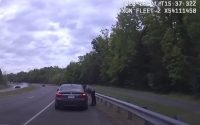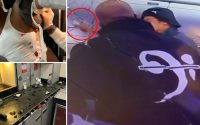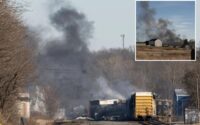What went wrong in Maui: Outrage over apparent failings
Ten days after a series of apocalyptic blazes decimated large swaths of Maui and killed at least 111 people, locals were on Friday still searching for the spark behind the deadliest US wildfire in over a century.
The Justice Department announced Thursday that a specialist National Response Team from the Bureau of Alcohol, Tobacco, Firearms and Explosives (ATF) has been tasked with officially investigating the cause of the blaze that reduced the historic coastal town of Lahaina to ash.
“We were all devastated to learn of the loss of life and property,” ATF Special Agent in Charge Jonathan McPherson said, adding that it will “hopefully bring some healing to the community.”
The feds will likely have plenty to look at, according to infuriated locals who have angrily blamed a slew of failures for the historic disaster that still has more than 1,000 people unaccounted for.
That includes allegations of careless electrical company bosses, harried fire crews and thoughtless emergency warning leaders.

‘There was no warning’
Within hours of the flames scorching their neighborhoods, thousands of displaced Maui residents expressed horror that there had not been an evacuation siren.

“There was no warning. There was absolutely none,” Lynn Robinson, who lost her home in the fire, told The Post last week. “Nobody came around. We didn’t see a fire truck or anybody.”
Instead, locals said they only avoided perishing thanks to luck and warnings from caring neighbors.

“A friend who is a lifeguard comes over on a bike,” Lahaina resident Pam Reader said of her family’s survival. “He was covered in soot and he just said ‘It’s time to go. You have to get out of the house.’”
Maui’s Emergency Management Agency Chief Herman Andaya defended his decision not to activate the siren — saying he feared it would be mistaken for a tsunami warning, sending people racing to higher ground.

“Then they would have gone into the fire,” he claimed. “So even if we sounded the siren, we would not have saved those people out there on the mountainside.”
Just a day later, Andaya stepped down amid the intense backlash, blaming “health reasons.”

Power company lawsuit
Hawaii’s main power supplier is already subject to a class-action lawsuit for failing to shut off the island’s power grid amid troubling weather conditions.
“There is credible evidence, captured on video, that at least one of the power line ignition sources occurred when trees fell into a Hawaiian Electric power line,” said Mikal Watts, one of the lawyers behind the suit.

Those videos include a clip taken by Shane Treu, who recalled hearing a “buzz, buzz” as a power line snapped and started a “blazing” fire just hours before the wildfire took hold and became uncontrollable.
“In a matter of minutes, that whole place was just engulfed,” Treu said of the fire that locals say soon reignited after it had been declared under control.
The old power lines were supposed to be replaced in 2019, but the company pushed back the work, Watts alleged.

Data from Whisker Labs, which collects and analyzes electrical grid stats, recorded dozens of sparking power lines in areas where fires likely started and around the times they are believed to have begun.
“Nobody likes to turn the power off — it’s inconvenient,” said Michael Wara, a wildfire expert who is director of the Climate and Energy Policy Program at Stanford University.
“But any utility that has significant wildfire risk, especially wind-driven wildfire risk, needs to do it and needs to have a plan in place. In this case, [Hawaiian Electric Co.] did not.”

Hawaiian Electric president and CEO Shelee Kimura deflected criticism at a Monday news conference, saying that the company had to consider the need for specialized medical equipment and water pumps.
Still, the utility is performing an internal review, he said.
‘Why did they leave?’
The same earlier, caught-on-camera fire also led to angry criticism of fire crews who were accused of leaving it to restart hours later.
Maui’s fire department tackled the brushfire from about 6:37 a.m. that Tuesday, declaring it “100% contained” by 9 a.m., and leaving it early that afternoon.
Instead, it restarted and spread uncontrollably from about 3:30 p.m., according to outraged locals.
“Why did they leave?” local resident Dominga Advincula, 55, asked in an interview with the San Francisco Chronicle.
“If they could wait an hour or 30 minutes … that small fire in the afternoon? They could’ve saved everybody else. Couldn’t they just spare one truck for two more hours?”

Hawaii Fire Fighters Association labor union president Bobby Lee blamed it on fire crews being “overwhelmed.”
“You’ve got only so many resources.” he told the Honolulu Civil Beat. “When you look at what was going on, it looks like they were tapped out.”

Water debacle
Firefighting abilities were also compromised by a state official’s refusal to release water to West Maui landowners until it was too late, four sources familiar with the situation told the Honolulu Civil Beat.
M. Kaleo Manuel, the Department of Land and Natural Resources’ (DLNR) deputy director for water resource management, hesitated at the West Maui Land Co.’s request for additional water to prevent fire spreading on August 8, the source alleged.
The company manages several agricultural and residential subdivisions, many of which were damaged in the wildfires.
Manuel, a Native Hawaiian cultural practitioner, wanted West Maui Land to get permission from a taro, or kalo, farm downstream from its property, the sources explained.
By the time Manuel released the water, the flames had already spread.
While Manuel declined to comment to the outlet, Gov. Josh Green spoke candidly about the history of water disputes on the island, which he said had been exacerbated by climate change and wildfires.
“We have a difficult time on Maui and other rural areas getting enough water for houses, for our people, for any response,” Green said, according to the Civil Beat.
“But it’s important we start being honest. There are currently people still fighting in our state giving us water access to fight and prepare for fires even as more storms arise.”
Green also confirmed that the state is readying a “comprehensive review” of decisions made before and during the deadly fires.
Volatile plants
Part of the explanation for the horrifying events of Aug. 8 may be natural: The invasive, highly flammable plant species that have made a home on Maui for the last several years.
When irrigated pineapple and sugar cane crops declined, non-native, fire-prone grasses moved in, said Elizabeth Pickett, the co-executive director of the Hawaii Wildlife Management Organization.
The grasses — including guinea grass, molasses grass and buffelgrass — were imposed on the island as a drought-proof solution to livestock raising.
When the dry grasses burn, Pickeet explained, they decimate the native forests and endangered species – which are then replaced with more grass.
“These grasses are highly aggressive, grow very fast and are highly flammable,” Melissa Chimera, whose grandmother lived on the Hawaiian Commercial & Sugar Co.’s plantation in Maui after emigrating from the Philippines, told the New York Times.
“That’s a recipe for fires that are a lot larger and a lot more destructive.”
‘Where’s the president?’
Along with anger at the failures leading to the fire, the historic disaster has left many in Maui feeling abandoned and let down by President Biden, who isn’t planning to visit until Monday, nearly two weeks after the wildfire and as more than 1,000 people remain unaccounted for.
“It’s really affecting me because where’s the president?” one emotional resident, Ella Sable Tacderan, asked on CNN while fighting back tears late Thursday.
“I mean, aren’t we Americans, too? We’re part of the United States. Why are we getting put in the back pocket? Why are we being ignored?” she asked, while calling the onetime federal grant of $700 a “slap in the face.”
While sunning himself on the beach, Biden has repeatedly refused to discuss the disaster — then seemingly forgot Maui’s name when he finally did.
With Post wires


